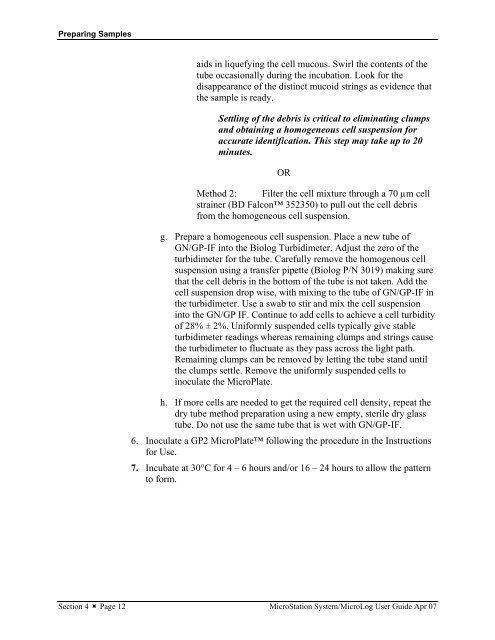MicroStation System, MicroLog Version 4.2 - DTU Systems Biology ...
MicroStation System, MicroLog Version 4.2 - DTU Systems Biology ...
MicroStation System, MicroLog Version 4.2 - DTU Systems Biology ...
Create successful ePaper yourself
Turn your PDF publications into a flip-book with our unique Google optimized e-Paper software.
Preparing Samples<br />
aids in liquefying the cell mucous. Swirl the contents of the<br />
tube occasionally during the incubation. Look for the<br />
disappearance of the distinct mucoid strings as evidence that<br />
the sample is ready.<br />
Settling of the debris is critical to eliminating clumps<br />
and obtaining a homogeneous cell suspension for<br />
accurate identification. This step may take up to 20<br />
minutes.<br />
Section 4 � Page 12 <strong>MicroStation</strong> <strong>System</strong>/<strong>MicroLog</strong> User Guide Apr 07<br />
OR<br />
Method 2: Filter the cell mixture through a 70 µm cell<br />
strainer (BD Falcon 352350) to pull out the cell debris<br />
from the homogeneous cell suspension.<br />
g. Prepare a homogeneous cell suspension. Place a new tube of<br />
GN/GP-IF into the Biolog Turbidimeter. Adjust the zero of the<br />
turbidimeter for the tube. Carefully remove the homogenous cell<br />
suspension using a transfer pipette (Biolog P/N 3019) making sure<br />
that the cell debris in the bottom of the tube is not taken. Add the<br />
cell suspension drop wise, with mixing to the tube of GN/GP-IF in<br />
the turbidimeter. Use a swab to stir and mix the cell suspension<br />
into the GN/GP IF. Continue to add cells to achieve a cell turbidity<br />
of 28% ± 2%. Uniformly suspended cells typically give stable<br />
turbidimeter readings whereas remaining clumps and strings cause<br />
the turbidimeter to fluctuate as they pass across the light path.<br />
Remaining clumps can be removed by letting the tube stand until<br />
the clumps settle. Remove the uniformly suspended cells to<br />
inoculate the MicroPlate.<br />
h. If more cells are needed to get the required cell density, repeat the<br />
dry tube method preparation using a new empty, sterile dry glass<br />
tube. Do not use the same tube that is wet with GN/GP-IF.<br />
6. Inoculate a GP2 MicroPlate following the procedure in the Instructions<br />
for Use.<br />
7. Incubate at 30°C for 4 – 6 hours and/or 16 – 24 hours to allow the pattern<br />
to form.


